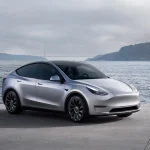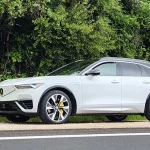
Could Fisker Karma’s Low MPGs Hurt DoE Car-Tech Loan Program?Could Fisker Karma’s Low MPGs Hurt DoE Car-Tech Loan Program?
Fisker Automotive may have sensed that the 20-mpg EPA rating on their 2012 Karma electric sport sedan was not good news.
The company simply omitted the statistic from their press release announcing that the EPA had legally certified the Karma–meaning it can now be sold to retail buyers.
Fisker said the EPA had rated the Karma at 54 MPGe (MPG-equivalent) when running on electricity from its battery pack, and that the EPA-rated electric range would be 32 miles.
20 mpg omitted from release
But the other half of the window sticker–the 20-mpg rating for a Karma running on power from its range-extending gasoline engine–appeared nowhere in the release.
The only other series hybrid on the market, the 2012 Chevrolet Volt–with a less powerful electric motor and smaller gasoline engine–is rated at 94 MPGe in electric mode, and 37 mpg on gasoline, with an electric range of 35 miles.
The EPA’s “miles-per-gallon-equivalent” is calculated based on how far an electric car can travel on battery energy equivalent to 1 gallon of gasoline. The most energy-efficient electric car in the U.S. is the 2012 Mitsubishi ‘i’ minicar, rated at 112 MPGe.
Will critics pounce?
Electric-car advocates privately express concern that critics both of electric cars and of the DoE low-interest loan program that helped fund Karma development will jump all over the gas-mileage figure, using it to criticize DoE efforts to aid advanced vehicle technologies.
Dr. Steven Chu, U.S. Secretary of Energy
Broadly, loans through the $25 billion DoE program go toward retooling existing plants at least 20 years old to build vehicles with fuel efficiency at least 25 percent higher than current cars.
In September 2009, Energy Secretary Steven Chu announced that the DoE would grant Fisker Automotive $529 million in low-interest loans through its Advanced Technology Vehicle Manufacturing program.
A total of $8 billion in loans had been awarded in June 2009, with the largest sums to Ford and Nissan. Here’s the list of automakers granted loans to date:
FORD [NYSE:F]
Amount: $5.9 billion, awarded in June 2009
Work Funded: Plant retooling in five states to build 13 models with electric, hybrid, or more efficient gasoline powertrains, including Ford’s EcoBoost turbocharged gasoline direct-injection engines
Gas Mileage: 39 mpg combined gas mileage rating for 2012 Ford Fusion Hybrid
2012 Ford Fusion Hybrid
NISSAN [NSDQ:NSANY]
Amount: $1.6 billion, awarded in June 2009 (in the end, Nissan used only $1.4 billion)
Work Funded: Retooling of Tennessee assembly plant to build Nissan Leaf electric car, plus construction of plant to build lithium-ion cells for battery packs
Gas Mileage: 99 MPGe for 2011 Nissan Leaf
FISKER AUTOMOTIVE [privately held]
Amount: $529 million, awarded in September 2009
Work Funded: $169 million for engineering integration work on the Karma; $360 million for development of a mid-size extended-range electric vehicle, to be built in a former GM plant in Wilmington, Delaware
Gas Mileage: 54 MPGe for 2012 Fisker Karma in electric mode; 20 mpg in range-extended mode
2012 Tesla Model S beta vehicle, Fremont, CA, October 2011
TESLA MOTORS [NSDQ:TSLA]
Amount: $465 million, awarded in June 2009
Work Funded: Engineering and assembly of the 2012 Tesla Model S all-electric sport sedan, in a former GM-Toyota plant in Fremont, California, as well as battery-pack assembly facilities
Gas Mileage: The 2012 Tesla Model S is not yet in production and has not been rated by the EPA
So does the 2012 Fisker Karma’s low EPA mileage rating set a bad example for the type of innovation the DoE loan program is meant to promote?
Certainly the Karma can plug into grid power to travel purely on electricity, which no other luxury sports sedans can do. And its 20 mpg is no worse than, say, the 2012 Mercedes-Benz CLS 550, with its combined EPA rating of 20 mpg.
But we suspect the perennial drumbeat of criticism and contempt for electric cars will continue, especially given another DoE loan in the news of late: Solyndra.
Ray Lane takes delivery of the first Fisker Karma
What do you think? Is the Karma’s 20-mpg gas mileage a liability for the DoE low-interest loan program? Is it appropriate for the DoE to make such loans in the first place?
Tell us what you think in the Comments below.
+++++++++++
Follow GreenCarReports on Facebook and Twitter.
View original article at: “https://www.greencarreports.com//news/1067530_could-fisker-karmas-low-mpgs-hurt-doe-car-tech-loan-program”
Add a comment Cancel reply
Comments (0)
บับเบิ้ล กันกระแทก
… [Trackback]
[…] Find More Info here on that Topic: autoseu.com/could-fisker-karmas-low-mpgs-hurt-doe-car-tech-loan-programcould-fisker-karmas-low-mpgs-hurt-doe-car-tech-loan-program/ […]
jarisakti
… [Trackback]
[…] Read More on on that Topic: autoseu.com/could-fisker-karmas-low-mpgs-hurt-doe-car-tech-loan-programcould-fisker-karmas-low-mpgs-hurt-doe-car-tech-loan-program/ […]
สล็อตเว็บตรง
… [Trackback]
[…] Read More on that Topic: autoseu.com/could-fisker-karmas-low-mpgs-hurt-doe-car-tech-loan-programcould-fisker-karmas-low-mpgs-hurt-doe-car-tech-loan-program/ […]
Categories
- Activism (1)
- Adventure (1)
- Advertising (2)
- Agriculture (1)
- Air pollution (4)
- Air transport (3)
- aluminium (2)
- Amazon (3)
- Animals (1)
- Apple (2)
- Architecture (1)
- Arctic (1)
- Artificial intelligence (1)
- Augmented Reality (1)
- Auto Detailing (1)
- autopilot (1)
- battery (31)
- Best summer holiday destinations 2022 (1)
- Bicycle (1)
- biodiversity (1)
- BMW (2)
- boat (1)
- Bus (1)
- Business (4)
- Buying Guides (1)
- car (7)
- Car industry (18)
- Car News (18)
- car rental (3)
- Car Reviews (4)
- Car sales (6)
- carbon emissions (15)
- carbon footprint (3)
- Carlos Ghosn (1)
- Cars (66)
- Central Europe (1)
- CES (2)
- charging station (11)
- Children (1)
- China (12)
- Citroën (1)
- city (1)
- City transport network (2)
- clean energy (2)
- Climate (1)
- climate change (9)
- Climate crisis (4)
- Climate emergency (2)
- climate protection (2)
- CO2 emissions (39)
- Company (3)
- Competition (1)
- Conscious travel (2)
- Contamination of water (1)
- Copper (2)
- cost of living (2)
- Cuba (1)
- Cuban politics (1)
- Cybertruck (1)
- Cycling (1)
- deforestation (1)
- delivery (3)
- Denmark (2)
- Detroit (1)
- Diesel (4)
- Diesel car (7)
- e-mobility (11)
- e-scooter (2)
- Eco travel (3)
- Eco-friendly (2)
- Ecology (1)
- Economy (1)
- El Niño (1)
- Electric (11,302)
- Electric boats (1)
- electric car (107)
- Electric Cars (499)
- Electricity (5)
- Electricity consumption (3)
- Electricity market (5)
- Elon Musk (21)
- emission (1)
- Emmanuel Macron (1)
- Energy (2)
- Energy low cost (1)
- energy transition (6)
- Entrepreneur (1)
- Environment (5)
- Environment pollution (1)
- Environmental protection (4)
- EU Policy (1)
- EU-China (2)
- Europe (7)
- Europe's energy crisis (1)
- European Commission (3)
- European economy (2)
- European Union (18)
- Euroviews (6)
- Eviction (1)
- EVs (37)
- F1 (1)
- factory (4)
- fake news (1)
- family (2)
- Ferrari (1)
- fertilizer (1)
- fine (penalty) (1)
- fire station service (1)
- flight (1)
- Flying car (4)
- Food security (1)
- Ford (1)
- Formula 1 (2)
- Fossil fuels (14)
- France (39)
- free trade (1)
- Fuel (3)
- Fuel cell electric vehicles FCEV (10)
- fuel crisis (2)
- Fuel Efficiency (3)
- fuel prices (1)
- Funeral (1)
- Gas (1)
- Gas Prices (1)
- gasoline price hike (1)
- German (1)
- Germany (8)
- Giorgia Meloni (1)
- Global warming and climate change (1)
- Good News (1)
- Greece (1)
- green energy (1)
- green new deal (1)
- Green transportation (17)
- Green Week (1)
- greenhouse gas emissions (6)
- Hanoi (19)
- Health (1)
- home (2)
- homelessness (1)
- Housing market (19)
- human rights abuse (1)
- Hybrid (2,283)
- Hybrids (116)
- Hydrogen (2)
- hydrogen vehicle (2)
- IAA Mobility (2)
- Iceland (3)
- incident (1)
- income (1)
- India (2)
- Indonesia (1)
- infrastructure (1)
- innovation (1)
- International relations (1)
- Investment (4)
- iPhone (1)
- Japan (1)
- Jobs (3)
- Joe Biden (4)
- Jubilee (1)
- Lampedusa (1)
- Las Vegas (1)
- lead petrol (2)
- Lithium (13)
- liveable cities (2)
- London (3)
- Luxembourg (1)
- Luxury (2)
- luxury goods (2)
- Luxury lifestyle (2)
- Manufacturing (5)
- Market (1)
- Markets (1)
- meat (1)
- Mercedes-Benz (39)
- Migrants (1)
- minerals (2)
- Mining (5)
- Mitsubishi Motors (1)
- Mobile World Congress (1)
- Mobility (10)
- Mobility Week (2)
- Mobility Week 2021 (1)
- Mobility Week 2023 (5)
- money (3)
- Motorcycling (2)
- Motorsport (1)
- Mountain (1)
- NASA (1)
- nature (2)
- net-zero (2)
- New technologies (6)
- Next Explainers (1)
- Next In data (2)
- Nigeria (1)
- Nissan (3)
- Norway (7)
- Nuclear Energy (1)
- nuclear fusion (1)
- Nuclear power plant (1)
- Odd (1)
- oil industry (1)
- Olaf Scholz (1)
- online shopping (1)
- Oslo (1)
- Paris (1)
- parody (1)
- Petroleum products (3)
- Peugeot (1)
- plastic (1)
- Poland (1)
- Politics (1)
- Pollution (44)
- Power Plant (1)
- prices (1)
- production (1)
- Profits (1)
- Prostitution (1)
- Public transport (4)
- Racing cars (1)
- Racism (1)
- Rail transport (2)
- rats (1)
- Raw material (1)
- Recycling (4)
- Renault (3)
- Renewable energies (6)
- renewable energy (6)
- Reykjavík (1)
- Rishi Sunak (1)
- road (36)
- Road infrastructures (1)
- Road safety (7)
- Road transport (20)
- road trip (1)
- Robot (1)
- Rolls Royce (1)
- Russia (1)
- Russia's invasion of Ukraine (2)
- Sadiq Khan (1)
- safari (1)
- Safety (1)
- Sale (1)
- sales (3)
- Scotland (1)
- self-driving (43)
- Semiconductor (1)
- Shares (1)
- Show (1)
- Silicone (1)
- Software (1)
- Solar energy (2)
- solar power (5)
- Space technology (1)
- Spain (1)
- start-up (3)
- Stock exchange transaction (1)
- Stock market activity (1)
- Stockholm (1)
- Strasbourg (1)
- Students (1)
- Summer Olympics (2)
- Sustainability (7)
- Sustainable city (3)
- Sustainable design (3)
- Sustainable development (1)
- Sustainable innovation (9)
- Sustainable technology (21)
- Sustainable tourism (4)
- Sweden (2)
- Tata Motors (2)
- Tax (37)
- Taxes (2)
- Taxi (1)
- Technology (55)
- Tesla (73)
- The Boring company (1)
- Tokyo Olympic Games 2020 (1)
- Toyota (4)
- trade (3)
- traffic (1)
- Trains (2)
- Transport (11)
- transportation (3)
- Travel destinations (1)
- Tunnel (1)
- Twitter (3)
- UBER (1)
- Ukraine war (1)
- Uncategorized (6)
- United Kingdom (5)
- United States (6)
- urban planning (2)
- Ursula von der Leyen (3)
- US politics (1)
- USA (1)
- vegan (1)
- vehicle (7)
- Video (4)
- Vietnam (19)
- Volkswagen (3)
- Volvo (2)
- waste (1)
- waste disposal (1)
- Water (1)
- Water resources (1)
- White House (1)
- wind energy (1)
- Wind turbine (1)
- Winter (2)
- work conditions (1)
- World Travel Market (1)
- Xiaomi (1)
Recent Posts
About us

Popular Tags
Related posts


Volvo EX30 in the test: Really a premium car at a volume price?

VW ID.7: Estate is not called Variant... It's a Tourer







